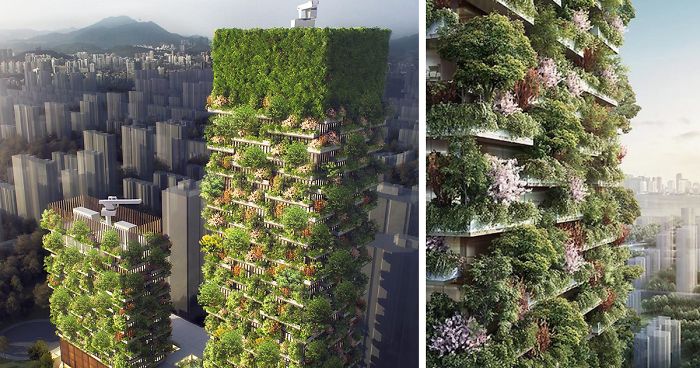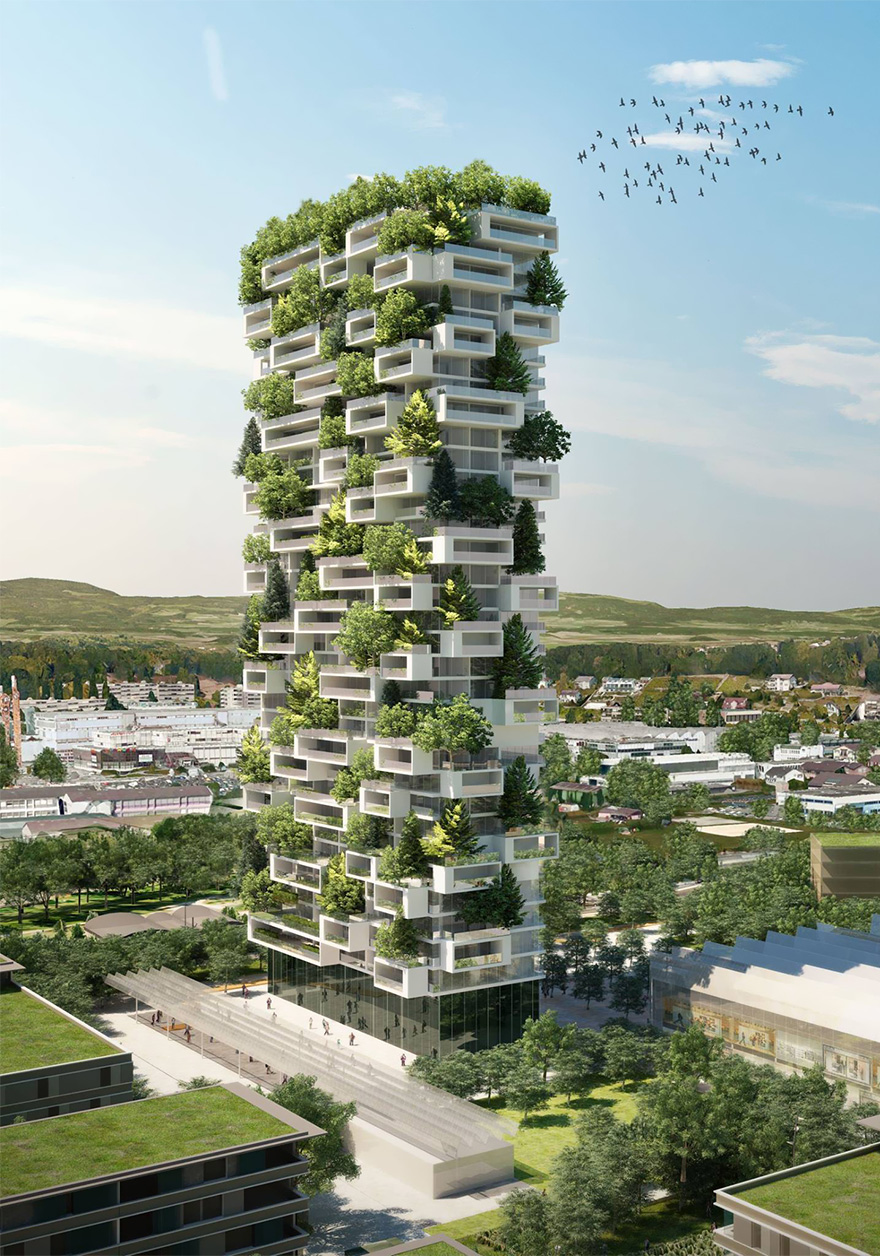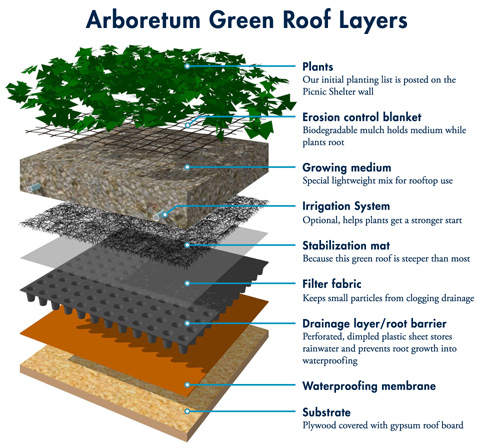
First Vertical Forest In Asia To Have Over 3,000 Plants And Turns CO2 Into 132 Pounds Of Oxygen Per Day
It’s a good job that these vertical forests in Nanjing, China are going to produce 132 pounds (60kg) of oxygen every day, because they’ll literally take your breath away when you see them.
They’re called the Nanjing Towers, and once they’re complete in 2018 they’ll be Asia’s first ever vertical forests. Designed by Italian architect Stefano Boeri, each tower will stand 656ft and 354ft respectively, and between them they’ll house over 1,000 trees and approximately 2,500 shrubs from 23 different local species. The taller tower will contain offices, a museum, a green architecture school and a rooftop club, while the smaller tower will house a rooftop pool and a 247-room Hyatt hotel. Balconies will afford visitors stunning views of the dizzying vertical forests that are intended to help regenerate local biodiversity. These aren’t the first vertical forests that Stefano has designed however. Two have already been built in Milan and similar buildings have been planned for Lausanne, Switzerland. In an increasingly polluted world, these green designs are a real breath of fresh air.
More info: Stefano Boeri | Facebook (h/t: inhabitat, mymodernmet)
These towers in Nanjing, China will contain vertical forests that will house 2,500 shrubs and over 1,000 trees
The 23 different tree varieties will produce around 132 pounds (60kg) of oxygen every day
They were designed by Italian architect Stefano Boeri and they will be completed in 2018
Similar buildings have also been planned by the architect for Lausanne, Switzerland
And two vertical forests, called Bosco Verticale, have already been built in Milan, Italy
471Kviews
Share on FacebookAny air quality improvement endeavour from China directly affects us in Korea. This project is good news
Except for one thing Daria. Trees, and bushes have roots, and roots have no problem with slowly breaking up hard objects, such as concrete. All of this looks great in artist's rendering, but over time, those balconies holding all that weight and vegetation, will break off and drop on to the ones below. Unless they can come up with something more enduring, this will not work, over time.
Load More Replies...I hope the architect takes into account the potential extra weight the tower will put on with all those plants growing and gaining weight lol.
What worries me more is the roots that grow into the walls, slowly destroying them. But seeing so many actual parks planted on the rooftops of various buildings, I guess they found a way.
Load More Replies...As beautiful as they are, it is no answer to the CO2 problem. Governments will claim it gives them licence to keep using fossil fuels when these can only take a tiny amount produced by any country. Also, there is the point of the other pollutants from petrol and diesel which are very toxic to breathe in and they won't be absorbed by the trees. Switch to green energy. That is the only solution.
This is pretty but seems a tad overly optimistic. It's great, that the last example is actually real and looking great, but let's see how it looks in ten years. Trees are a LOT of work to maintain. -_-
http://www.odditycentral.com/architecture/this-living-building-in-bogota-is-the-worlds-largest-vertical-garden.html
Its all fun and games until a branch falls of and hurts a pedestrian under the tower.
Imagine if an entire city was made of these buildings instead of glass towers.
How are these trees and foliage sustained. The roots are limited as is the soil?
Would assume these buildings would have a full time grounds keeper.
Load More Replies...I think it is a good idea, to help with the air quality, but I can't help but think it would be better if we weren't creating the problem in the first place.
I disagree with this design. Branches can damage glass windows during strong winds, especially on high rises. Broken branches dive down to pedestrians as bullets that can kill instantly.
A Cute idea to be sure- but obviously this architect is not a inveterate grower of plants. Ever try to grow a tree in a wind tunnel? It doesn't work. The wind forces around such a tall building are going to be quite prohibitive to growth- regardless of the species chosen.
So, if it produces 60 kg or oxygen a day and of the air we breathe in 20% is oxygen, whilst we consider a person breathes in 13 kg of air per day then this whole building produces enough clean air for 23 people?
Surely it will only create oxygen and take in carbon while the trees are still growing? So you'd have to keep cutting them down and doing something with the wood...like burning it for fuel. :)
WOW what a concept. China needs these all over their cities! It will be interesting to see what happens after these trees grow for a few years!!
I can't help but think that the arguments about CO2 and oxygen are not the main point of the exercise. The walls of plants make people feel good. Lots of plants raise people's mood. More plants lead to fewer antidepressants for city folk.
Does anyone find it disturbing that we live in a time where China is make efforts on the environmental front, whereas the power-that-be in the USA is mocking climate change?
I think the problem of roots digging into concrete can be solved by covering the porous concrete with a hard and smooth material.
Congrats, you created a building that produces not enough oxygen to even account for the number of people who will be working there to maintain it. Tell me again how eco friendly this is?
656 feet and only 132 pounds of oxygen. Is that good? How much oxygen would a lawn covering the same area produce?
If there were a cannabis tower, and the structure caught fire, would pizza sales in the city increase exponentially?
We have the same project by the same architect in Milan, as the article says. For what I know, it requires a very high maintenance and gardeners use some kind of climbing rope to clean and cure the trees. I think that if you keep on with the maintenance you could avoid the roots damaging the structure of the building. These apartments are f*cking expensive, and maintenance fees are crazy too.
Will these also be build to artficially increase the GDP? And become yet another uninhabited city?
It certainly looks beautiful. I hope it turns out to be as great as it seems...the world could use a lot of these!
I cannot remember my photosynthesis - how many kilos of CO2 does it take to make that 60 kilos of O2? Put another way, how much carbon does the process covert into plant mass. Simply stripping off the carbon atoms would yield 22.5 kilos of carbon a day, but it can't be that simple - some carbon gets used up / discarded, right?
That will solve the problem of air polution in Bejing and Shanghai , they should just plant fast growing paulownia :)
India should be doing this, since it's more polluted over there. http://www.npr.org/2016/11/23/503108925/india-is-home-to-10-of-the-worlds-most-polluted-cities
Load More Replies...Yeah, that is reeeeally not going to do much good until they begin making laws that put an EPA in charge of making companies adhere to strict anti-pollution policies! It is SO polluted in China, they have ABSOLUTELY ZERO possibility of seeing a sunrise OR a sunset! They film them from ABOVE the pollution and show them on HUGE screens all over the major cities.
Any air quality improvement endeavour from China directly affects us in Korea. This project is good news
Except for one thing Daria. Trees, and bushes have roots, and roots have no problem with slowly breaking up hard objects, such as concrete. All of this looks great in artist's rendering, but over time, those balconies holding all that weight and vegetation, will break off and drop on to the ones below. Unless they can come up with something more enduring, this will not work, over time.
Load More Replies...I hope the architect takes into account the potential extra weight the tower will put on with all those plants growing and gaining weight lol.
What worries me more is the roots that grow into the walls, slowly destroying them. But seeing so many actual parks planted on the rooftops of various buildings, I guess they found a way.
Load More Replies...As beautiful as they are, it is no answer to the CO2 problem. Governments will claim it gives them licence to keep using fossil fuels when these can only take a tiny amount produced by any country. Also, there is the point of the other pollutants from petrol and diesel which are very toxic to breathe in and they won't be absorbed by the trees. Switch to green energy. That is the only solution.
This is pretty but seems a tad overly optimistic. It's great, that the last example is actually real and looking great, but let's see how it looks in ten years. Trees are a LOT of work to maintain. -_-
http://www.odditycentral.com/architecture/this-living-building-in-bogota-is-the-worlds-largest-vertical-garden.html
Its all fun and games until a branch falls of and hurts a pedestrian under the tower.
Imagine if an entire city was made of these buildings instead of glass towers.
How are these trees and foliage sustained. The roots are limited as is the soil?
Would assume these buildings would have a full time grounds keeper.
Load More Replies...I think it is a good idea, to help with the air quality, but I can't help but think it would be better if we weren't creating the problem in the first place.
I disagree with this design. Branches can damage glass windows during strong winds, especially on high rises. Broken branches dive down to pedestrians as bullets that can kill instantly.
A Cute idea to be sure- but obviously this architect is not a inveterate grower of plants. Ever try to grow a tree in a wind tunnel? It doesn't work. The wind forces around such a tall building are going to be quite prohibitive to growth- regardless of the species chosen.
So, if it produces 60 kg or oxygen a day and of the air we breathe in 20% is oxygen, whilst we consider a person breathes in 13 kg of air per day then this whole building produces enough clean air for 23 people?
Surely it will only create oxygen and take in carbon while the trees are still growing? So you'd have to keep cutting them down and doing something with the wood...like burning it for fuel. :)
WOW what a concept. China needs these all over their cities! It will be interesting to see what happens after these trees grow for a few years!!
I can't help but think that the arguments about CO2 and oxygen are not the main point of the exercise. The walls of plants make people feel good. Lots of plants raise people's mood. More plants lead to fewer antidepressants for city folk.
Does anyone find it disturbing that we live in a time where China is make efforts on the environmental front, whereas the power-that-be in the USA is mocking climate change?
I think the problem of roots digging into concrete can be solved by covering the porous concrete with a hard and smooth material.
Congrats, you created a building that produces not enough oxygen to even account for the number of people who will be working there to maintain it. Tell me again how eco friendly this is?
656 feet and only 132 pounds of oxygen. Is that good? How much oxygen would a lawn covering the same area produce?
If there were a cannabis tower, and the structure caught fire, would pizza sales in the city increase exponentially?
We have the same project by the same architect in Milan, as the article says. For what I know, it requires a very high maintenance and gardeners use some kind of climbing rope to clean and cure the trees. I think that if you keep on with the maintenance you could avoid the roots damaging the structure of the building. These apartments are f*cking expensive, and maintenance fees are crazy too.
Will these also be build to artficially increase the GDP? And become yet another uninhabited city?
It certainly looks beautiful. I hope it turns out to be as great as it seems...the world could use a lot of these!
I cannot remember my photosynthesis - how many kilos of CO2 does it take to make that 60 kilos of O2? Put another way, how much carbon does the process covert into plant mass. Simply stripping off the carbon atoms would yield 22.5 kilos of carbon a day, but it can't be that simple - some carbon gets used up / discarded, right?
That will solve the problem of air polution in Bejing and Shanghai , they should just plant fast growing paulownia :)
India should be doing this, since it's more polluted over there. http://www.npr.org/2016/11/23/503108925/india-is-home-to-10-of-the-worlds-most-polluted-cities
Load More Replies...Yeah, that is reeeeally not going to do much good until they begin making laws that put an EPA in charge of making companies adhere to strict anti-pollution policies! It is SO polluted in China, they have ABSOLUTELY ZERO possibility of seeing a sunrise OR a sunset! They film them from ABOVE the pollution and show them on HUGE screens all over the major cities.

 Dark Mode
Dark Mode 

 No fees, cancel anytime
No fees, cancel anytime 


































734
76